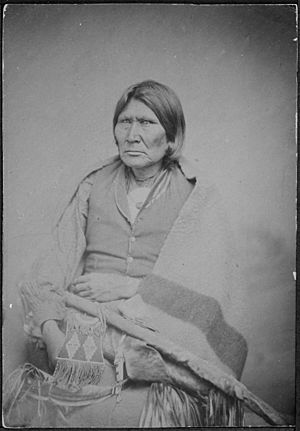Horseback (Comanche) facts for kids
Horseback (Comanche, Tʉhʉya Kwahipʉ or Kiyou horse back) (1805/1810-1888) was a Nokoni Comanche chief.
Contents
Young man: warrior and war chief
In his prime, he made his career under the elder Huupi-pahati (Tall Tree), head chief of the Nokoni band, and Quenah-evah (Eagle Drink), second chief and later successor to Huupi-pahati himself possibly after the smallpox and cholera epidemics occurred in 1849; during the 1840s and 1850s he gained a good fame as a war leader against the Comanche's Indian enemies and a raider through Texas.
Diplomat and peaceful leader
In 1861, along with the Yamparika head chief Ten Bears and the Penateka chiefs Tosahwi (White Knife) and Asa-havey a.k.a. Esihabit (Milky Way), went to Fort Cobb where they met General Albert Pike (C.S.A.), and the Comanche chiefs (including Quena-evah) signed for an allegiance with the Confederate States of America. He became head chief of the Nokoni after Quena-evah's death or retirement, possibly in 1866. Not a long time after Peta Nocona (Lone Wanderer)'s death about 1864, and having become Parua-ocoom (Bull Bear) the new first chief of the Kwahadi Comanche, Kobe (Wild Horse) second Chief of Kwahadi took with him the two adolescent sons of the dead Kwahadi chief and grandsons of Iron Jacket, Quanah Parker and Pecos, to complete their training as young men and warriors; the two youngsters settled with the Nokonis, their foster grandfather Tabby-nocca (Lean Elk)'s kinsmen, under the supervision of Horseback.
Horseback was involved, like Esihabit and some other chiefs, in the policy of ransoming white prisoners from the other Comanche bands, and in January 1867 he or Esihabit (according to two different versions) were the makers of young Theodore "Dot" Babb (kidnapped in September 1865 or 1866) ransoming, bypassing the U.S. authorities.
Horseback signed for the Nokoni the Medicine Lodge Treaty (Oct. 21 1867), emerging as the leader of the "peaceful" faction of the band, but the second-ranking chief, Big Red Meat, took the leadership of the uncompromising faction, and on the same "hostile" line was Tahka (Arrowpoint), war chief of Tʉhʉyakwahipʉ's own party. According to the treaty, signed by ten Comanche chiefs (Tʉhʉyakwahipʉ a.k.a. Kiyou, for the Nokonis; Parua-wasamen, his sons Esananaka and Hitetetsi, Howea, Tipenavon, Puhiwitoya, Saddyo for the Yamparikas; Tosawi and Ceachinika for the Penatekas) obliged the signing Comanches to go and settle into a reserve under the surveillance of Fort Cobb's garrison.
On December 12, 1868, while Tʉhʉyakwahipʉ was not in his village in the spot after known as Soldier Spring, a battle occurred there against 3rd Cavalry and 37th Infantry U.S. troops; the soldiers came on the village and the war chief Tahka reacted against the "long knives" leading the Nokoni warriors to fight; the Nokoni were defeated, Tahka being killed in the battle, and the village was burnt and stocks destroyed.
Attack on Horseback's village
On December 19, 1868 a large Comanche and Kiowa band faced a company of 10th Cavalry (Maj. Meredith H. Kidd) on the way from Fort Arbuckle to Fort Cobb. On December 25, six companies of the 3rd Cavalry and one company of 37 Infantry, with 12 officers and 446 troopers (Canadian River Expedition, led by Maj. Andrew W. Evans), with a battery of mountain howitzers, on the way from Fort Bascom crossing the Texas Panhandle to the Antelope Hills, and then turning south toward the Wichita Mountains, on December 12 came on the Nokoni village (about 60 tipis) of Horseback and Tahka, where Yamparika chief Howea was as a visitor; Horseback, the peaceful civil chief, was not in the camp, and Tahka’s blood was still boiling after the Washita massacre perpetrated by lt. col. George A. Custer and his 7th Cavalry less than one month before. Seeing the soldiers arriving, and being taunted by the Kiowa allies, Tahka, the war chief, led the Comanche warriors in a charge. He was killed and the village and the stocks were destroyed. Kiowa warriors led by Manyi-ten came to take part in the fight; Big Red Meat's Nokonis and Mow-way's Kotsotekas run to the fight; only one soldiers was killed. Within December 1868, exhausted after lack of food and freezing weather, the Nokoni went to Fort Cobb and there surrendered.
The last fight for freedom
Like Tosahwi, Horseback managed to keep out the Nokoni preventing their involvement in the Red River War in 1873–1874, but only a minor faction of Nokoni band followed him along the "peace road", and he lost most of his former followers, while Big Red Meat joined the hostile Comanche and Kiowa faction, uniting himself and his Nokoni warriors to Quanah Parker, Parra-ocoom, Kobay-oburra (Wild Horse), Kobay-otoho (Black Horse), Isatai'i, and their Quahadi Comanche, to Mow-way and his Kotsoteka, to Tabananika (Sound-of-the-Sunrise), Isa-rosa (White Wolf) and Hitetetsi aka Tuwikaa-tiesuat (Little Crow), son to Ten Bears, and their Yamparika, and to the Kiowa led by Guipago, Satanta, Zepko-ete (Big Bow), Tsen-tainte (White Horse) and Mamanti (Walking-above).
The sunset years
After the Palo Duro campaign (1874) and the surrendering of the last hostile Comanche groups coming back from the Staked Plains, Horseback was appointed by the Army as head chief of all the Comanches, and was ordered to pick out the "worst" Comanche, to send them to Fort Marion, Florida; the same happened to Kicking Bird for the Kiowas, and the Kiowa chief pointed out 27 chiefs and warriors, but Horseback was able to sacrifice only nine men (one Black Horse - Tu-ukumah -, but probably not Kobay-otoho third chief of the Quahadi band, and eight "outlawed" warriors), preventing the deportation of all the defeated chiefs (but, unfortunately, not the life of Parua-ocoom, dead on June 27–28, 1874, during the Adobe Walls fighting, and that of Big Red Meat, dead in the icehouse – temporarily used as a jail – of Fort Sill on January 1, 1875. Together with Quanah and some of the old chiefs, Horseback was a constant point of reference for the Comanche people in the reservation until his death in 1888.


